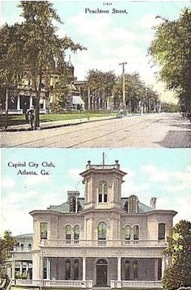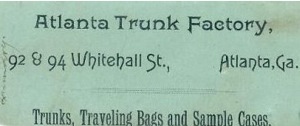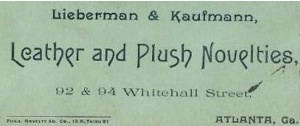





This is the AFL-CIO
Union Facts
Atlanta’s Washerwomen Strike
With the official end of slavery less than two decades before, thousands of black laundresses went on strike for higher wages, respect for their work and control over how their work was organized. In summer 1881, the laundresses took on Atlanta’s business and political establishment and gained so much support they threatened to call a general strike, which would have shut the city down.
Life as a Laundress in 1880s Atlanta
Atlanta in the early 1880s was just beginning to develop. Less than two decades had passed since the Civil War ended. The city had primitive water and sewer systems, and unsanitary trash lined the unpaved streets. Atlanta’s businessmen and politicians sought to paint a very different picture to lure northern businesses to the city, spotlighting it as the urban center of the New South with a large, subservient workforce.
More than half of the city’s black residents—and half of the black wage earners—were women. Black women largely were responsible for sustaining not only their families but their communities as well. One-third of black women living in Atlanta, as in other cities, raised families alone.
Nearly all (98 percent) of these black working women were household workers. On average, women began working as domestics between age 10 and 16 and worked until age 65 or older. In the 1880s, more black women worked as laundresses than in any other type of domestic work. The city had more laundresses than male common laborers. In contrast, only a small portion of white women worked for pay, and the average white family could afford the services of at least a washerwoman.
Laundry work was the most difficult of domestic jobs, and industrialization made the chore even more dreadful. Manufactured cloth—especially washable fabrics such as cotton—made clothing more available so people had more clothes than ever before. Laundry work was the first chore women would hire someone else to perform if her family had the slightest bit of extra money. In the North, women would send their family’s dirty clothes to a commercial laundry at the time. But in the South, technology was lagging and even poor whites could send some wash to black women.
Laundresses worked long, tiring hours and their wages ranged from $4 to $8 a month. These wages changed little over time and laundresses would increase their earnings by adding on clients or getting help from their children. Laundresses worked mostly in their own homes or in their neighborhoods with other women. They worked outside in the shade when weather permitted or inside their homes, hanging clothes all over the house to dry.
They made their own soap from lye, starch from wheat bran and washtubs from beer barrels cut in half. Their work began on Monday mornings and continued throughout the week until the clean clothes were delivered on Saturday. Throughout the week, they would carry gallons of water from wells, pumps or hydrants for washing, boiling and rinsing clothes. Then, after hanging the clothes to dry, the women would iron, alternately using several heavy irons at a time.
"I could clean my hearth good and nice and set my irons in front of the fire and iron all day [with]out stopping....I cooked and ironed at the same time," said laundress Sarah Hill.
The Summer of 1881
In July 1881, 20 laundresses met to form a trade organization, the Washing Society. They sought higher pay, respect and autonomy over their work and established a uniform rate at $1 per dozen pounds of wash. With the help of black ministers throughout the city, they held a mass meeting and called a strike to achieve higher pay at the uniform rate.
The Washing Society, or "Washing Amazons," as their opponents called them, established door-to-door canvassing to widen their membership, urging laundresses across the city to join or honor the strike. They also involved white laundresses, who were less than 2 percent of laundresses in the city—an extraordinary sign of interracial solidarity for the time.
In three weeks, the Washing Society grew from 20 to 3,000 strikers.
By August, municipal authorities were taking direct action, arresting strikers, fining members and making house visits. The laundresses were not deterred. But the white establishment was so agitated that city politicians got involved. The City Council proposed that members of any washerwoman’s organization pay an annual fee of $25 and then offered nonprofit tax status to businesses that wanted to start commercial laundries. Even though the $25 fee would mean several months of wages, the strikers were not discouraged. They responded with a letter to the mayor, agreeing to pay the fees rather than be defeated. "We mean business...or no washing," the letter stated.
These politically savvy women workers were willing to pay the fee in exchange for self-regulation. To them, self-regulation of their industry was about respect. In the post-Civil War South, the laundresses refused to be seen as subordinate. These laundresses saw the strike as asserting their freedom and identity and gaining respect for their work.
The resolve of the striking laundresses—despite the arrests, fines and proposed fees—inspired other domestic workers. Cooks, maids and nurses began demanding higher wages. Hotel workers went on strike. Unlike past strikes, employers—aware of the magnitude of the black labor unrest—weren’t confident they could find replacement workers. So the following week, the City Council rejected the proposed fees. The laundresses had prevailed.
In the end, the strike not only raised wages—it, more importantly, established laundresses—and all black women workers—as instrumental to the New South’s economy. The white establishment was forced to acknowledge that black women workers, who were former slaves, were not invisible.
Sources
Hunter, Tera W. To ‘Joy My Freedom: Southern Black Women’s Lives and Labors After the Civil War. Harvard Press, 1997; Greenfeld, Carl. The Identity of Black Women in the Post-Bellum Period, 1865-1885. Binghamton Journal of History, Spring 1999
Copyright © 2008 AFL-CIO | American Federation of Labor - Congress of Industrial Organizations





